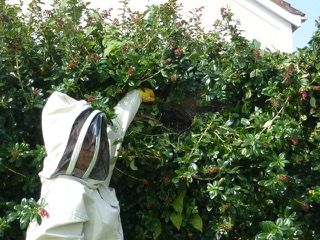|
SBKA member Lynne Ingram reports from the front line fighting Asian hornets in Jersey
Today we headed off to the Bowls Club to remove the nest from the hedge. The nest was actually destroyed by the pest controllers yesterday after a man was hospitalised, so the hornets themselves will be dead. The pest controllers inject a contact insecticide at pressure into the nest. The hornets inside should die fairly quickly and the ones that are out should die when they return and contact the insecticide. Unfortunately sometimes dead and dying hornets covered in insecticide powder fall out of the nest onto the ground below. This can be a hazard to the public but also birds and other things that could come into contact with them. In this case the nest was inside the hedge, so any hornets would have fallen down inside. We were kitted up in bee suits and Bob Hogge was resplendent in his hornet suit, but there were no hornets around. The nest was quite small – about 1 foot across with 2 layers of cells and was possibly a late secondary nest – perhaps where the queen was disturbed at her first nest location. As you can see in the photo it was totally hidden within the hedge, and no one had noticed hornets flying in and out. We then headed off to the La Preference area where a team had been tracking a nest for a few days, and were reporting up to 15 hornets at their bait station. They had an idea where they thought the nest was but just couldn’t pin it down. The trapping was complicated by hundreds of wasps being attracted to the Suterra that we were using in the bait stations, and people were getting stung. A new volunteer, who was a keen fly fisherman had been recruited to the team, and was experimenting with sticking feathers onto the thorax of the hornets, to aid in tracking their flight, as in wooded areas it is easy to lose sight of the hornets in flight against the trees. He had cut a slot in a queen marking cage to accommodate the feather, but needed to balance it being big enough for us to see, against the ability of the hornet to fly once it was stuck on. It is surprising how much a feather can weigh – you just don’t consider it until trying to stick it to a hornet! In the evening we were counting and sorting dead hornets from a large nest that had previously been removed and killed without insecticide. We counted around 700 hornets that had been found within the nest, and were trying to sort them by size, being newly emerged or with visible sting. The idea was to see if there were any drones or queens present, but this is very difficult as there are no obvious external differences. Queens are often heavier – 500mg plus, but workers can weigh from 230 – 400mg depending on the amount of food received as a larva. Drones can only really be differentiated by the extra antennal segment, or by dissection. Comments are closed.
|
Archives
March 2024
Categories
All
|
Somerset Beekeepers Association Charity © 2021 Registered CIO Charity 1206483
Affiliated to the British Beekeepers Association
Click here to view our Privacy Policy
Affiliated to the British Beekeepers Association
Click here to view our Privacy Policy

 RSS Feed
RSS Feed
